Huddled at the east end of St Paul's cathedral,
across the road to St Augustine Watling Street,
St Vedast is one of my favourites of all the City
of London churches, especially of the smaller
ones. It is one of those City churches which has
no real reason for existing - indeed, it nearly
didn't. There are no resident parishioners, it
has no particular splendour or historical
significance. It is small enough to almost
disappear behind the shopping temples of modern
Cheapside. Perhaps that is why I love it so much.St Vedast was a Bishop of Arras in
Picardy whose cult was popular in the 13th
Century. Probably, there were merchants from
Flanders in this part of Cheapside who dedicated
the church to him. His name was corrupted into
English as St Forster or St Foster, and although
the church is ordinarily dedicated to St Vedast
these days thanks to the medieval enthusiasms of
the Victorians, it still sits on Foster Lane.
The church is one of a
jigsaw of little churches around St Paul's, their
ingenious spires intended by Wren and Hawksmoor
to emphasise the sheer bulk of the cathedral
dome. In fact, St Vedast was almost not part of
this puzzle. After the Great Fire, the energetic
parish got to rebuilding its church against its
old tower independently on the lines of the old
one, and it wasn't until as late as 1695 that the
Wren workshop came along, pulled it down and put
up a new church, drawing the north aisle into a
widened nave and leaving the south aisle towards
Cheapside. The tower and steeple at the west end
of the aisle was the final touch, erected about
1710 to Hawksmoor's design. As Pevsner says, it
is the most baroque of all the City steeples. It
was, however, the Wren church that came in at the
cheapest price, which may be explained when you
know that restoration work in the 1990s revealed
much of the outer walls to be medieval in
construction. Wren had reused the shell of the
old church.
In 1919, St Vedast was one
of 19 City churches selected for demolition by
the Diocese of London's City of London Churches
Committee. The plan was to sell off the land and
use the money to build churches in the
north-western suburbs. The church, measuring only
23 yards by 17 yards, would perhaps not have
provided a fortune, especially as it was hoped
that the tower would be kept.
Ewan Christian had
reordered the interior quietly in the 1880s,
leaving alone the 17th Century reredos and
communion table, which everyone seems to have
admired: the table supported by caryatid
saints, the reredos an ordered but complicated
array of Corinthian pilasters, flowers, fruit,
mitres, flaming torches, putti musicanti, and a
pelican in her piety over and around the four
tables of the Creed, the Commandments and the
Paternoster, wrote Wayland Young. There was
a west gallery - Christian moved the organ out of
it into the south side of the chancel - and a
royal arms on the north wall. Margaret Tabor,
writing in 1917, was struck by the large number
of old monuments, none of them of very great
interest.
This, then, was the church
which was destroyed by incendiaries and high
explosives on the night of Sunday 29th December
1940. The London Blitz had the two-fold effect of
ridding the Diocese of more churches than it had
originally planned to demolish, and also
completely reducing the value of City land for a
generation to come. When the dust settled, it was
decided that St Vedast would be one of the
churches to be repaired and restored - St
Augustine Watling Street across the road would
only be kept as a tower, to be worked into the
replacement choir school. St Vedast was never a
major City church, and perhaps the architect
chosen for the job was secretly glad that he
could get on without too much interference or
noise from those keeping a beady eye on the likes
of St Bride and St Mary le Bow.
He was Stephen Dykes Bower,
the last of the unrepentant Gothicists. In his
1994 obituary in the Times, Stephen James
described Dykes Bower as a devoted and
determined champion of the Gothic Revival style
through its most unpopular years. He rejected
modernism and continued traditions from the late
Victorian period, emphasising fine detail,
craftsmanship and bright colour. It is also
worth recalling what Pevsner had written about
Dykes Bower's restoration of the great church of
St Nicholas at Great Yarmouth in Norfolk,
similarly destroyed in the Blitz: What an
opportunity was lost! What thrilling things might
have been done inside! A modern interior, airy,
noble, of fine materials could have arisen to
affirm the vitality of C20 church architecture
inside the C13 walls. How defeatist does the
imitation-Gothic interior appear, once this has
been realized!
In the
early 1960s, Dykes Bower reimagined St Vedast as
a college chapel. The seating, with rests, faces
inwards across a mosaic-tiled floor. All
memorials, some of which came from churches of
parishes subsumed into that of St Vedast, were
relegated to the south aisle, which is screened
off from the nave, access only possible at the
eastern end. The glass is by Brian Thomas, who
had worked successfully with Dykes Bower at Great
Yarmouth and other places. Everything is of the
highest quality. Not all the furnishings are to
Dykes Bower's design. The 17th Century reredos
from St Christopher le Stocks, which had been
taken by Ernest Geldart to Great Burstead in
Essex, was brought back to London and installed
here.
Despite
Dykes Bower's reactionary enthusiasm for the
past, there is a Festival of Britain jollity to
the interior - prayerful, yes, but also with that
confidence of the post-war years. It is a
thrilling interior, perfect for music-led
worship, especially candle-lit on a winter
evening. And Dykes Bower has been proved right,
of course. His reinvented interiors here, and at
Great Yarmouth, and especially at St Edmundsbury
Cathedral are perfectly suited to quiet 21st
Century Anglican worship.
Simon Knott, December 2015
location: Foster Lane, Cheapside
EC2V 6HH - 2/062
status: working parish church
access: open seven days a week: Monday
to Friday 8am - 6pm, Saturday 10am-4pm, Sunday
morning
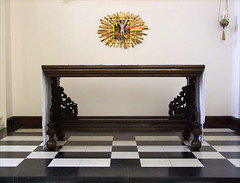 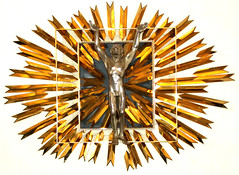 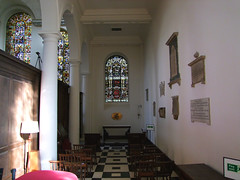 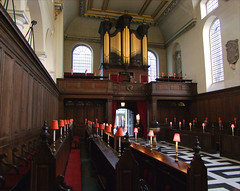 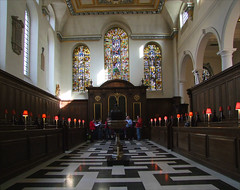
 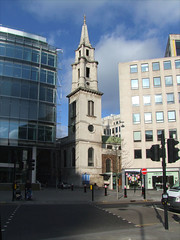 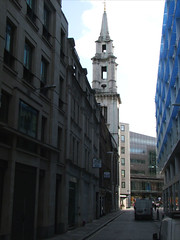 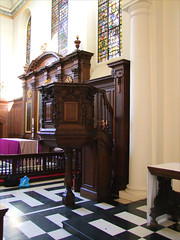 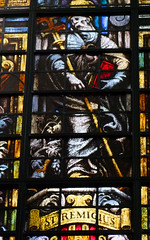
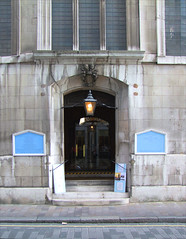 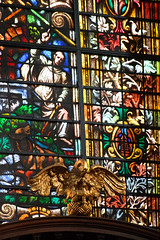   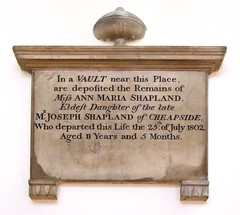 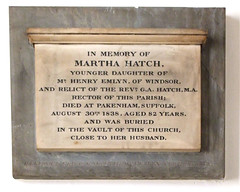 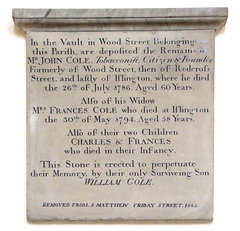   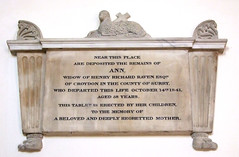 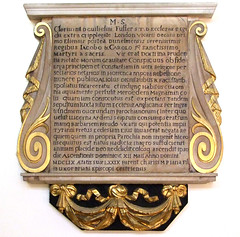 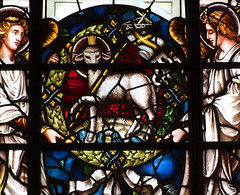  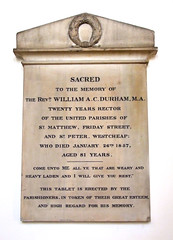 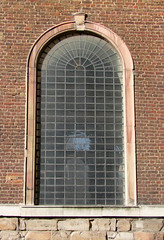 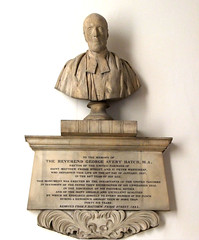 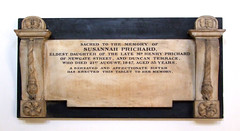 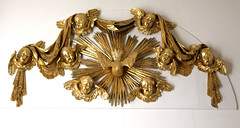   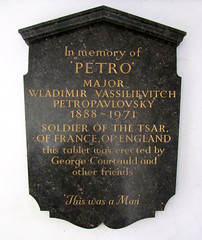 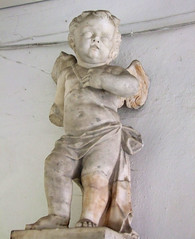 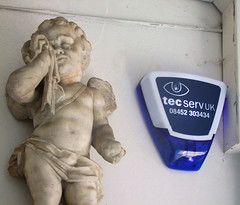 
Commission
from Amazon.co.uk supports the running of this
site
|
|
|
|
|
|
|
|
|
|
|
|
|
|
|
|


